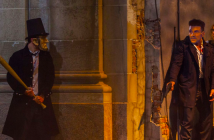
Editor’s Note: This month marks the 50th anniversary of Who’s Afraid of Virginia Woolf? (1966). Feel free to share your memories of this film in the comments section below.
The 1960s are known for their cultural and political upheaval. By 1966, Civil Rights, Desegregation and Voting Rights had all been passed, LBJ was halfway through his elected term as President (after serving a little more than one to complete JFK’s term), the war in Vietnam was kicking into high gear, the Beatles had released Revolver, the Beach Boys released Pet Sounds, Bob Dylan released Blond on Blond and everyone was getting “tuned in”. Everyone, that is, except Hollywood executives. They were still bent on producing big-budget musicals and insisted on clinging to their outdated production code that served to censor anything that could be vaguely considered ‘lewd’ by one or two individuals who were speaking for an entire country, nay, world, on what could or couldn’t be seen in a motion picture. The MPAA was still two years away from ditching the production code entirely in favor of the first version of the ratings system we all know now.
Enter: Mike Nichols, the Broadway phenomenon who had started as a comedy actor and rose to fame due to his Broadway shows with Elaine May (who later became a film director herself). After their show came to an end, he turned to directing and had several hits running at the same time. Hollywood came calling and he answered, since he was looking for something new to sink his teeth into. At first, he was going to make his debut as a director with The Graduate, but the script was not ready (nor was any studio), so he turned to Edward Albee’s stage play Who’s Afraid of Virginia Woolf?
The story of a bitter, argumentative, aging intellectual couple who come apart at the seams in front of a young couple in the drunken haze of a post-cocktail party ‘after-party’ in their home was not something that, at the time, would have even been considered as a viable film property. The sheer level of vulgarity and swearing alone would have excluded it even a year or two earlier and Nichols had to fight to keep what he had in the film, though it was apparently toned down from the play. He secured screen legends Elizabeth Taylor and Richard Burton, themselves intensely combative with each other and were in the midst of their second marriage to each other having previously divorced (this would happen again at least once more, their divorcing and returning to one another only to divorce again), to play George (Burton) and Martha (Taylor) with the young couple being played by George Segal (Nick) and Sandy Dennis (Honey).
At its center, the film is an actor’s paradise. Each of the four actors took major risks with their characters and how they interpreted them. Taylor stands out the most because she plays Martha as incredibly crass and lewd, quite unlike the cultivated and debonair persona she’d crafted (though her fights with Burton were legendary even then) and even more than that, she agreed to wear age make-up and gained weight for the roll, taking her supernatural beauty and burying it to become Martha. She was only 34 at the time (only two years older than Segal, who was playing the much younger man) but she more than inhabited the body of a woman in her late-40s here, swearing and yelling and braying (as George puts it) throughout the film. Her performance was so good she earned her second Oscar for the roll (Denis also won for Best Supporting Actress, Burton and Segal were both nominated but neither took home the trophy). Taylor usually gets the spotlight for the film because of her brave and uncharacteristic portrayal, and rightfully so, but Burton’s measured and often quiet performance is just as powerful in a completely different way. He plays along with Martha sometimes, other times he strikes back at her and he’s always looking for information on his guests. He sees that Martha is not-so-subtly coming on to Nick and George does what he can (which, it turns out, is a lot) to make Nick look and feel foolish in front of both Martha and Honey. Denis plays Honey as aloof and as she gets drunker, she becomes more and more aloof, never quite realizing what’s going on around her, while Segal’s Nick is right in the middle of all of it, sometimes thinking he’s befriending his hosts and other times realizing he’s being attacked and other times he’s just an uneasy voyeur stuck watching a theater of the absurd, forced to stay by the performers.
The actors’ performances are certainly what most people remember about the film, but without Nichols’ sure-handed direction, even those powder-keg performances would not have held the picture afloat. Nichols pulled off what few film directors have been capable of when filming a play: he never makes you feel that used to be one. He not only expands the setting from one room to multiple locations inside and outside the house, but his blocking and arraignment of the sets opens up the play into the world of the pseudo-real, i.e. film. Yet, despite opening up the scenery, he keeps things contained, letting the dialogue create a stifling atmosphere, constraining the actors and the audience in this drawn-out battle between two embittered individuals that love each other despite the fact that they have nothing but contempt for the other. Nichols intensifies the claustrophobia by using hand-held, moving close-ups on the actors, seldom going for a wide-shot to include the room. He keeps us close to these people so we can feel as awkward as Nick.
These shots were courtesy of now-legendary cinematographer Haskell Wexler. His gorgeous black and white photography earned him an Oscar, though it was Nichols who insisted the film be shot in black and white, partially to aid and hide Taylor’s ageing make-up and partly because he felt the film was more suited to black and white. The choice paid off because George and Martha don’t live in a brightly lit, Technicolor world. They live in a dirty, black and white world where they are the only people that matter to each other and their bitterness and cynicism, depression and alcoholism have drained all the color out of their lives. Wexler’s shadows call attention to the fact that these two are in fact shadowy creatures, seldom revealing themselves and always playing games to obfuscate any twinge of reality about themselves yet laying themselves bare as they bicker and brawl.
Who’s Afraid of Virginia Woolf? was one of the first hammers to hit the rapidly crumbling columns of the studio system. It took veteran Old Hollywood actors and deglamorized them, something very anti-Hollywood and produced a film that feels so true and real it almost feels like a window into Taylor and Burton’s own troubled and tempestuous relationship, which they undoubtedly tapped into for their roles. It also heralded the arrival of a major new director who was unafraid of frank subject matter and who did not care about Hollywood conventions if they stood in the way of quality work. Nichols’ work was rewarded with an Oscar nomination (a prize which he took home the next year for The Graduate) and it also blazed the trail that led to the dismantling of the Production Code and helped force Hollywood into the new age.
When you peel off the label of Who’s Afraid of Virginia Woolf?, you get through, as George says, to the muscle and the sloshy bits down to the bone and more, into the marrow of what visionary cinema was and still is. You get a film that strips bare human emotion and lays it out for all to see. It’s raw, raucous, bitter, terse, funny, tragic and more, sometimes all in a few sentences. It takes no prisoners and actually makes you feel good by the end, if only because no matter how screwed up your relationship is, it’s nowhere near as bad as George and Martha’s.



